#men's islamic wear
Explore tagged Tumblr posts
Text
Top Trends in Men's Islamic Wear for Eid Festivities

Eid al-Fitr, also known as the Festival of Breaking the Fast, is a joyous celebration that marks the end of the holy month of Ramadan for Muslims around the world. As families and communities come together to commemorate this special occasion, it is important for men to dress in a manner that reflects the significance and cultural traditions of Eid. In recent years, there has been a rise in the popularity of Islamic wear, with modern designs and styles catering to the needs of fashion-conscious Muslim men. From traditional pieces to contemporary twists, the trends in men’s Islamic wear for Eid festivities continue to evolve and adapt to the changing times. In this article, we will explore the top trends in men’s Islamic wear for Eid, highlighting the fusion of tradition and fashion that has become the hallmark of modern Islamic clothing. Whether you are looking to make a statement or maintain a classic and modest look, these trends will surely inspire you to elevate your Eid wardrobe and make a stylish impact.
1. Traditional styles with modern twists
The world of men's Islamic wear has seen a remarkable evolution, blending traditional styles with modern twists to cater to the diverse fashion preferences of today's men. Embracing this fusion of old and new, the Emirati thobe for men and Emirati jubba have gained immense popularity. These garments, which have deep cultural roots, have been reimagined with contemporary elements, resulting in designs that exude elegance and sophistication. Rubyonlinestore.com offers a wide range of men's Islamic wear, including jubbas for men, that effortlessly combine traditional aesthetics with modern sensibilities. The intricate detailing, fine fabrics, and impeccable craftsmanship of these garments make them ideal choices for embracing both tradition and style during Eid festivities and beyond.
2. Rich colors and intricate details
The allure of men's Islamic wear lies in its rich colors and intricate details that bring a touch of opulence to any outfit. From vibrant jewel tones to earthy neutrals, the color palette of men's Islamic wear is diverse and captivating. These rich hues not only symbolize cultural significance but also add depth and dimension to the overall look. Complementing the array of colors are the intricate details found in the embroidery, embellishments, and patterns of these garments. Delicate motifs, geometric designs, and ornate stitching techniques showcase the remarkable craftsmanship and attention to detail that goes into creating these pieces. Whether it's a meticulously embroidered Emirati thobe for men or a finely adorned jubba, the combination of rich colors and intricate details adds an air of regality to men's Islamic wear, making it a timeless choice for Eid festivities and beyond. For a curated selection of men's Islamic wear that captures the essence of these top trends, visit rubyonlinestore.com, where you'll find a wide range of stylish and culturally-inspired garments.
3. Comfort and functionality prioritized
In addition to its aesthetic appeal, comfort and functionality are prioritized in men's Islamic wear. Designs are carefully crafted to ensure ease of movement and maximum comfort, allowing individuals to fully participate in Eid festivities without any hindrance. Fabrics used in the creation of Emirati thobes for men and jubbas are selected with great consideration, taking into account breathability and durability. The use of high-quality materials ensures that these garments withstand the test of time, allowing men to not only look stylish but also feel at ease throughout the celebrations. Whether it's the flowing silhouette of an Emirati thobe or the tailored fit of a jubba, men's Islamic wear combines both comfort and functionality, making it a practical choice for those seeking both style and ease. For a curated selection of men's Islamic wear that prioritizes comfort and functionality, visit rubyonlinestore.com, where you can discover a range of options that blend traditional craftsmanship with modern sensibilities.
4. Versatile pieces for multiple occasions
When it comes to men's Islamic wear, versatility is a key aspect that allows individuals to effortlessly transition from one occasion to another. Emirati thobes for men and jubbas are not just limited to Eid festivities; they can be worn for various other events and gatherings. These garments are designed with timeless elegance and sophistication, making them suitable for formal occasions such as weddings, religious ceremonies, and cultural events. The versatility of men's Islamic wear extends to its ability to be styled in different ways, whether it's pairing an Emirati jubba with tailored trousers or accessorizing a thobe with a traditional waistcoat. This adaptability ensures that these pieces can be worn beyond Eid festivities, making them a smart investment for any wardrobe. For a diverse collection of versatile and stylish men's Islamic wear, explore the offerings available at rubyonlinestore.com.
5. Sustainable and ethically-sourced fabrics.
In addition to style and versatility, the importance of sustainable and ethically-sourced fabrics cannot be overlooked when considering men's Islamic wear. With a growing global consciousness surrounding environmental impact and labor practices, it is crucial to prioritize materials that are both eco-friendly and socially responsible. Opting for garments made from sustainably sourced fabrics, such as organic cotton or recycled materials, ensures a reduced carbon footprint and minimal harm to the environment. Furthermore, choosing ethically-produced fabrics guarantees fair wages and safe working conditions for the workers involved in the manufacturing process. By selecting men's Islamic wear crafted from sustainable and ethically-sourced fabrics, such as those offered by rubyonlinestore.com, individuals can not only demonstrate their fashion-forward choices but also contribute to a more sustainable and socially conscious future.
As we approach the Eid festivities, it's clear that men's Islamic wear is evolving with the times. From modern interpretations of traditional styles to the incorporation of sustainable materials, these top trends are a reflection of the changing fashion landscape. As we celebrate this special occasion, let us embrace these trends and continue to showcase our cultural and religious identity through our clothing choices. May this Eid bring joy, peace, and a sense of unity to all.
0 notes
Text
obviously I'm all for complementarianism and Biblical male headship and gleaning wisdom from history, but Alisa Childers was so correct when she said some on the Christian right are trying to bring back a type of patriarchy that never existed
#you can argue that certain individual men exerted X 'authority' over their wives#but you cannot argue that said exertions were ever a social norm#the things you're arguing *for* are the very feminist strawmen you're reacting *against*#this is why I've not joined any dating websites--even the Christian or Conservative ones#because a guy can say he believes all the right things on paper#until you find out his version of 'complementarian' means 'the wife obeys the husband when he tells her to only wear red'#I need to know what kind of a family he comes from. what kind of a community he lives in. I don't trust a resume.#x#respublica#Christianity#sexuality#if your version of male headship starts to sound eerily like Islam or pimpmanship maybe some self-reflection is in order#or rather some Scripture-reflection
147 notes
·
View notes
Text

...I don't know if I should laugh or cry
(Also the article is real but i don't know how true this is. I'm pretty sure DW is reliable but I could be wrong.)
#welcome to islam kai????#the article said the person wearing the costume was a woman#strange burqa you got there 👀#anyways this article is old#idk if austria still has a burqa ban or what#also men dont wear burqa fyi#women dont need to either#ive never worn one before#ninjago#kai ninjago
6 notes
·
View notes
Note
have you seen those tiktoks where there’s a muslim tif going “how i style my hijab based on my gender as a genderfluid person”. like okay, but the reason you have to wear hijab in the first place is because you’re female. (i’m saying this as a culturally muslim female myself)
scream… “based on my gender” and yet you’re wearing an article of clothing specifically for women
#reminds me of the weirdo i saw on here claiming to be a man that wears the hijab bc men apparently do that in islam lmfao#like .. no the fuck they don’t what r u talking about
33 notes
·
View notes
Text
He killed a literal baby. And now he wants to sue the state for damages?!
By Anna Slatz February 14, 2024
A trans-identified male currently serving a 55-year sentence for the murder of his infant stepdaughter has launched a lawsuit against the Chaplain at his prison after he was allegedly denied a hijab despite identifying as a Muslim woman. Autumn Cordellioné, previously known as Jonathan C. Richardson, is seeking $150,000 in damages.
As previously reported by Reduxx, Cordellioné was first arrested in 2001 after his 11-month-old stepdaughter died in his care while her mother was at work. The night of the infant’s death, Cordellioné had been visited by friends who later told police that he had been “acting strangely.”
Despite claiming the little girl was inside sleeping, Cordellioné had loud music playing in the home, and his guests noted that he appeared to have a fresh, bleeding tattoo of the child’s name carved into his arm.

Autumn Cordellioné as of August 2023. Photo Courtesy: Indiana Department of Corrections.
Later that night, after his friends left, Cordellioné went to his neighbor and asked him to call 911, claiming the child was unresponsive. When emergency personnel arrived, they were briefly able to resuscitate the girl, but she died shortly after being rushed to the hospital.
Cordellioné was interviewed by police, who noted he was “calm and unemotional” during questioning, and his story about what happened to the baby changed dramatically over the course of the two interviews conducted.
At first, Cordellioné claimed he found the baby unresponsive after doing some household chores. But in the next interview, Cordellioné said the child was being “fussier than usual” and he attempted to throw her up in the air repeatedly in an effort to calm her down. He said her “head bopped forward and back up in a rough type of a manner,” and that the child continued to cry so he proceeded to shake her aggressively in an effort to calm her down.
During a failed appeals hearing, detectives from the case recounted how Cordellioné “physically showed” how he had manhandled the girl, getting up out of his chair and demonstrating the action in a rough manner.
An autopsy subsequently found that the baby had died of asphyxiation by manual strangulation. Cordellioné was booked awaiting a court hearing, and would later tell a prison official “all I know is I killed the little fucking bitch.”
Cordellioné was found guilty and sentenced to 55 years in prison for the horrific crime. He is currently incarcerated at the Branchville Correctional Facility, an institution for male offenders.
Last August, Cordellioné joined forces with the American Civil Liberties Union to sue the Indiana Department of Corrections, citing “discrimination” on the basis of his gender identity. That case is currently in progress.
But Reduxx has now learned that that Cordellioné has also launched a separate suit against the prison’s Chaplain, Tony Gray. Gray has been a Chaplain at the facility since 2014, and volunteered at the institution prior to being offered an official role.

Branchville Chaplain Tony Gray. Photo Source: Indiana Department of Corrections
In the lawsuit, filed on November 3, 2023, Cordellioné accuses Gray of violating his First, Eighth, and Fourteenth Amendment constitutional rights.
According to court records obtained by Reduxx, the incident of complaint took place in May of 2023 after Gray informed Cordellioné that he was not allowed to don a hijab outside of his cell. In response, Cordellioné said: “I wear the hijab in order to cover my head and ears for modesty purposes, as I am an Islamic practicing transwoman.”
At the time, Cordellioné’s registered religion was “Wiccan” and Gray pointed that out, to which Cordellioné replied that he was an “eclectic practitioner who is a member of the Theosophical Society in America.”
The Theosophical Society is headquartered in Chennai, India, and is considered an “esoteric new religious movement.” Founded in 1875, it describes itself as a “unsectarian body of seekers after Truth,” and its practitioners appear to dabble in the philosophy and beliefs of multiple religions simultaneously. One of its founders is Russian mystic Helena Petrovna Blavatsky, who stated in 1889 that “the purpose of establishing the Society was to prepare humanity for the reception of a World Teacher.”
Cordellioné is claiming that his equal protection rights were violated when he was barred from wearing a hijab outside of his cell, noting that male Muslims in the facility are allowed to wear kufis or taqiyah — a short, rounded brimless prayer cap.
“Islamic faith mandates the wearing of a kufi for males … Islamic faith also mandates females of the faith wear hijabs when outside the home and when not amongst men of their family. Tony Gray allows male Muslims to wear their sufis, but denies me, a transwoman, the same privilege.”

From the legal complaint filed by Cordellioné.
Cordellioné also alleges that Gray’s refusal to allow him to wear a hijab violated his eighth amendment rights against cruel and unusual punishment. In his argument, Cordellioné claims the he was subjected to “harassment and ridicule” by the Islamic community in his prison because he had not been allowed to wear a hijab.
“[Gray] should be aware, as Chaplain, the stigma and shame that is attributed to Islamic women when they go uncovered and without a hijab,” Cordellioné writes in his complaint. “Women are viewed as whores, tempters of men, and adulterators; by Islamic society both in and out of prison. I have been shunned, made a social pariah, and amongst my own religious community.”
He continues: “Without the support of the Islamic community, I will struggle and likely fail to achieve salvation for by [sic] Mohammed’s teachings a Muslim who knows of the teachings, yet strays from them, will never reach heaven.”
In his stated request for relief, Cordellioné is seeking the ability to wear his hijab in prison, as well as $150,000 in compensation.
Since filing, there has been some back-and-forth with the court surrounding Cordellioné’s financial situation, with the court requesting a nominal initial filing fee of $36.55, but Cordellioné claiming he does not have the money to pay it. If he cannot demonstrate deficiency in the time the court has specified, his case might be dismissed.
#Autumn Cordellioné is Jonathan C. Richardson#Criminals using gender identity to try to look like the victim#Branchville Correctional Facility#American Civil Liberties Union#ACLU defending violent men who claim to be women#Indiana Department of Corrections#Good for the Chaplin for standing up to a guy claiming to be an Islamic practicing transwoman#Theosophical Society in America#A lot of muslim men would not like him wearing a hijab#He wants to identify as a whole tempter of men and an adulteress?#Another guy who fetishizes submissiveness#He claimed to be Wiccan first#He's really trying to check of as many boxes for an oppression Olympics
12 notes
·
View notes
Text
pls....ppl from desert areas are COVERED in clothes so they dont DIE under the SUN --- enough belly dancing fits.....
#xx#ayla aescar#prompted me#tbh#but this is a common enough trope#like....ppl wear light loose fabric..even men cover themselves irl its not just islam its health#id have liked it if this particular thing was avoided...its so weird#lowkey fetishizing#ppl r so weird about head coverings too#if u want to have a naked™ society itmust bemilder weather#i guess ill use that myself
2 notes
·
View notes
Text
it's brain aneurysm inducing seeing how much people are misinformed about islam. by the way.
#islam doesnt see women less than men#its just become a social structure over the years of shitty people making it so wherever islam is the most common religion#it's still seen often in rural areas but it's not something the belief condones#prophet Mohammed literally has a hadith that says heaven lies beneath the feet of your mother#girl im not even muslim it makes me so mad seeing people be like “how can you believe in this religion!!” to women#acting like they cant research at their own pace and choose what they want to believe in . shut the fuck up#it's the same for wearing hijabs too. you dont have to wear them when you're not praying if you choose to do so#eden rambles#sorry
4 notes
·
View notes
Text
As a person who is NB and grew up a muslim the notes make me feel sick. western white people are so self centered, the world doesnt revolve around you, literally- all the person is doing is empowering her feminine side the way THEY want, and suddenly thats triggering. equality my ass, some of you people just want everyone to do what YOU want. female empowerment means letting them do what they want without your judgemental ass being a bitch about it, whether its wearing something or NOT wearing something. and i thought the notes are gonna be full of muslim extremists but no, just a bunch of triggered uneducated morons.
"this makes me hate this religion even more" well gee golly gosh thanks honey, nobody important likes you either, manchild of the year! :D
i may not be a devoted religious muslim anymore, but ill be damned to let people ruin other peoples faith when they are doing something so harmless- the bigots in the notes are the people who make this planet a punishment to live in. kindly fuck off and go watch your porn and objectify women silently in your parents basement or whatever youre actually good at.
#important#islam#fashion#designs#needs#inspo#fav#reference#honestly some people need to have their rights taken away from them#equality actually means doing whatever white people want#white men especially#fuck off#we will wear whatever we fucking want
89K notes
·
View notes
Text
3 Reasons Women Should do Charity
The Prophet Muhammad (ﷺ) once addressed a group of women and encouraged them to give charity. He said that he had seen that most of the people in Hell were women. The women asked why this was so. Why Women Should Be Mindful Women often curse and are ungrateful to their husbands. Women can be led astray easily. Women have some deficiencies in their intelligence and religion. What Are These…
View On WordPress
#ablution in islam women#anwarul islam women&039;s arabic college mongam#are men and women equal in islam#are women allowed to work in islam#beauty of islam women#best women in islam#brave women in islam#british women convert to islam#can men and women just be friends islam#can women do business in islam#can women drive in islam#can women fast during periods in islam#can women remove body hair in islam#can women shave their face in islam#can women use razor in islam#can women wear jeans in islam#can women work in islam#convert to islam women#divorce in islam women#dress code for women in islam#great women of islam book#hadith about women#how do women pray in islam#how to pray correctly islam women#islam about women job#islam beautiful women#islam for beginners women#islam woman convert#islam woman documentary#islam women
0 notes
Text

Human heads eaten by crows, unidentified and decomposing body parts, and hundreds of corpses piled up and buried in mass graves are all that remained of the victims of the massacre at al-Shifa Hospital. The grim scene was something out of a dystopian movie, the product of the two-week siege of Gaza’s largest hospital that ended in its total destruction. Following the completion of al-Shifa’s decimation, the Israeli army announced that it had been one of the most successful operations since the start of the war, claiming that it had arrested hundreds of Hamas and Palestinian Islamic Jihad members in the medical compound. But the question that no one seemed to ask is how such a massive number of so-called “operatives” from Hamas and PIJ had gathered at al-Shifa with the full knowledge that the place had already been combed by the army once before and that Gaza City had been occupied by the army ever since.
One young man who managed to escape the hospital mere moments before the army invasion began said that there had indeed been hundreds of Hamas and Palestinian Islamic Jihad-affiliated employees in the hospital, but none of them were military operatives. They were workers in the Gaza government’s civil branch, including Civil Defense crews, the police force, the internal security services, interior ministry employees, and employees of other branches of the local government. All of them had gathered to receive their governmental salaries at al-Shifa, given that it was one of the few remaining places that was supposed to be relatively safe from the fighting
When everyone left the buildings, the army began to separate the crowds of people into groups, making each group wear differently-colored plastic bracelets. The soldiers told them that these bracelets were connected to a system that alerts snipers to their movements. They were divided into two colors: yellow, which was attached to hospital staff and whoever the army considered civilians, and red, which was given to people who could not move on their own, such as patients, the injured, amputees, or people with broken limbs. The army also gathered people who were suspected of belonging to Hamas or the PIJ. They were not given bracelets but were separated from the injured and hospital staff, who were sent to a different building. A third much larger group was ordered to leave the hospital entirely — thousands of displaced persons who had been sheltering in the compound, in addition to some members of the hospital staff. Some of the staff members, including doctors, refused to leave. When they refused the army’s orders, they were executed immediately and without argument. The army then brought out a huge number of men from the group of suspected Hamas and PIJ members and employees, gathering them in the center of the courtyard. It then proceeded to execute them, one after the other. When the slaughter was done, army bulldozers piled up their corpses in the dozens, dragging them through the sand and burying them. As this was ongoing, other soldiers stormed various buildings in the compound in search of people who had refused to evacuate when the initial order was given. They killed anyone they found, regarding them as suspects.
This is a long article but I suggest you read the whole thing.
#yemen#jerusalem#tel aviv#current events#palestine#free palestine#gaza#free gaza#news on gaza#palestine news#news update#war news#war on gaza#al shifa hospital#war crimes#gaza genocide#genocide#long post
1K notes
·
View notes
Text
Inchallah My Lord has called me to serve Islam by being owned as alsabiu al'abyad sisi, taken by superior Muslim men, wearing burka,ayaba and niqab, trained to serve Muslims for breeding and seeding. It is the will of My Lord Allah to be enslaved white trash for the superior Muslim. Allah Akbar. 🙏 I can relocate to embrace my new Master #refugeeswelcome #sissywhitemeat4bbc

#caprice4muslims#bnwo propaganda#feminized and islamized#islam is winning#hijabi wife#whitewhore4muslimseed#whitemukhnith4muslimbreeding
273 notes
·
View notes
Text
Islam is the most misogynistic religion on earth. It’s the most oppressive cult for women among all abrahamic religions. Women can’t get out of their house. Women have to hide themselves in black tents they wear from head to toe. Women can’t even show one strand of hair. Check out the comments under any Pakistani female celebrity’s post and you will be disgusted. Women get attacked by religious bigots even for wearing half-sleeves. Women can’t initiate divorce easily and a lot of them are stuck in abusive marriages. Women are supposed to obey their husbands and can’t deny sex or they will be cursed by their god. Marital rape is allowed and encouraged in islam. Parents’ inheritance is not divided equally between brothers and sisters because women are expected to get married and rely financially on their husbands. Only men can be authority figures and be leaders, women are supposed to be quiet and submissive. Their prophet (idol) was literally a fuckin pedo. And these are just a few examples of how women are treated in islam. I don’t get how these dumbass muslim women still find the audacity to say shit like 'iSlAm iS tHe mOst peAceFul rEligIoN and tHe mOst fEmiNistic religion cAusE iT gAve wOmEn tHeIr rIgHts 1400 yeaRs aGo' what right?? Where’s the right lol?? All i see is oppression and violence in your religion. You can’t even give your opinion without some man’s permission but because his money is your money and your money is also yours you think islam fulfilled all your desires. It’s true that the more religious a person is, the more narrow-minded they are but muslim women have crossed all limits of stupidity. So glad i cut off such people from my life and saved one woman from converting to islam. ☪️ancer religion!!
#ex muslim#islam is cancer#anti religion#radblr#radical feminism#radical feminist community#radical feminist safe#radical feminist#feminism#radical feminists do interact
276 notes
·
View notes
Text
saying F U to the regime again and again: a quick update on women vs IR regime
Famous Iranian actresses have been appearing in public without a mandatory hijab. This has been happening since the beginning of the protests. Last month, Kiumars Pourahmad, a well known Iranian screenwriter and director, committed suicide. He had a history of criticizing the regime's political decisions. At his funeral, some of the famous actresses attended without mandatory hijab.
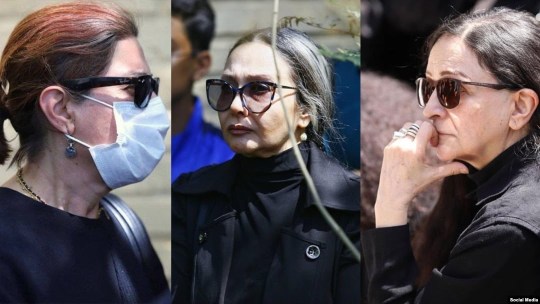
You can see Fateme Motamedarya, Katayoun Riyahi, and Golab Adineh in these pictures from the funeral. Ms. Riyahi was one of the first celebrities who took her hijab off at the start of the Jina (Mahsa) Amini protest and for that she's been the target of IRGC harassment and has been to court.
Last week, in the ceremony of screening of the final episode of Lion's Skin (a persian crime show), actress Pantea Bahram participated without hijab. The manager of Tehran’s Lotus Cinema, where the ceremony was held, was fired for letting her attend without hijab.
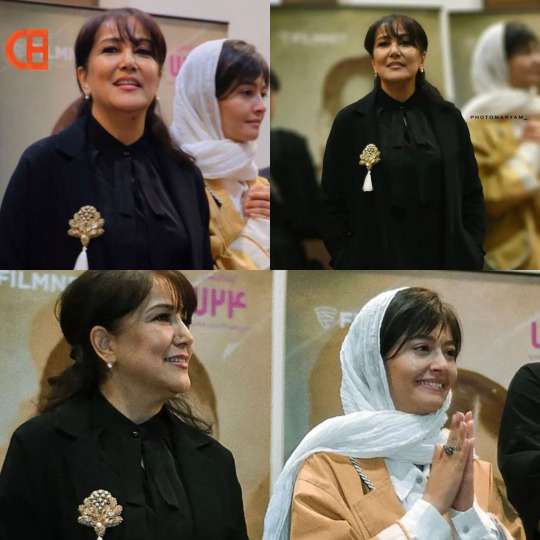
Other than prosecution, the regime has blocked these celebrities' bank accounts. Basij and IRGC members have also attacked and harassed these women online and in real life.
Students on university campuses take off their hijabs. There's an installed version of morality police in universities that monitor students' styles. Female students must wear "appropriate" hijab and male students must wear "manly" clothes (one of my guy friends once was asked to go back home and change his shoes because they were red casual loafers. Apparently that's gay!). When you enroll in Iranian universities, the first thing you do is to go to the security office and sign an agreement that says you promise to follow the Islamic dress code. There are posters all over the campus that says things like "hijab is security" "respect the islamic hijab" and "not wearing appropriate hijab (tight short clothes, too much hair, makeup, etc) would result in legal action". So not wearing hijab on campus, where a lot of security cameras are installed and it's easy to identify you, is a big deal.
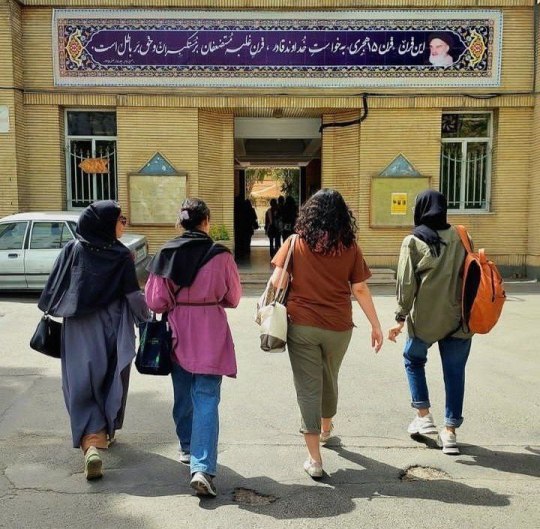

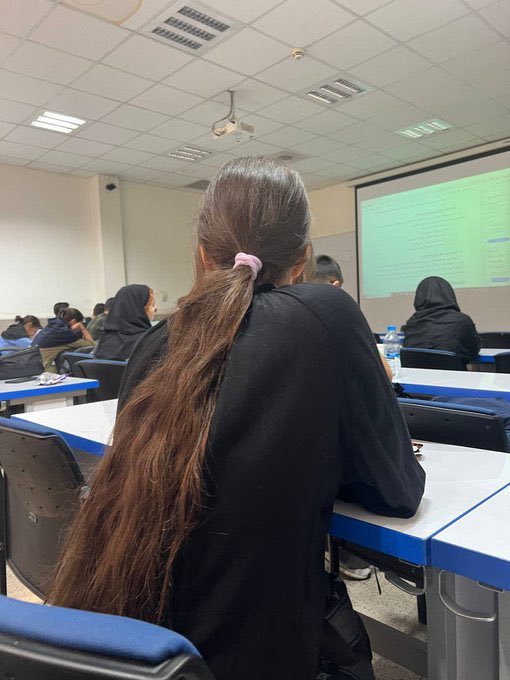
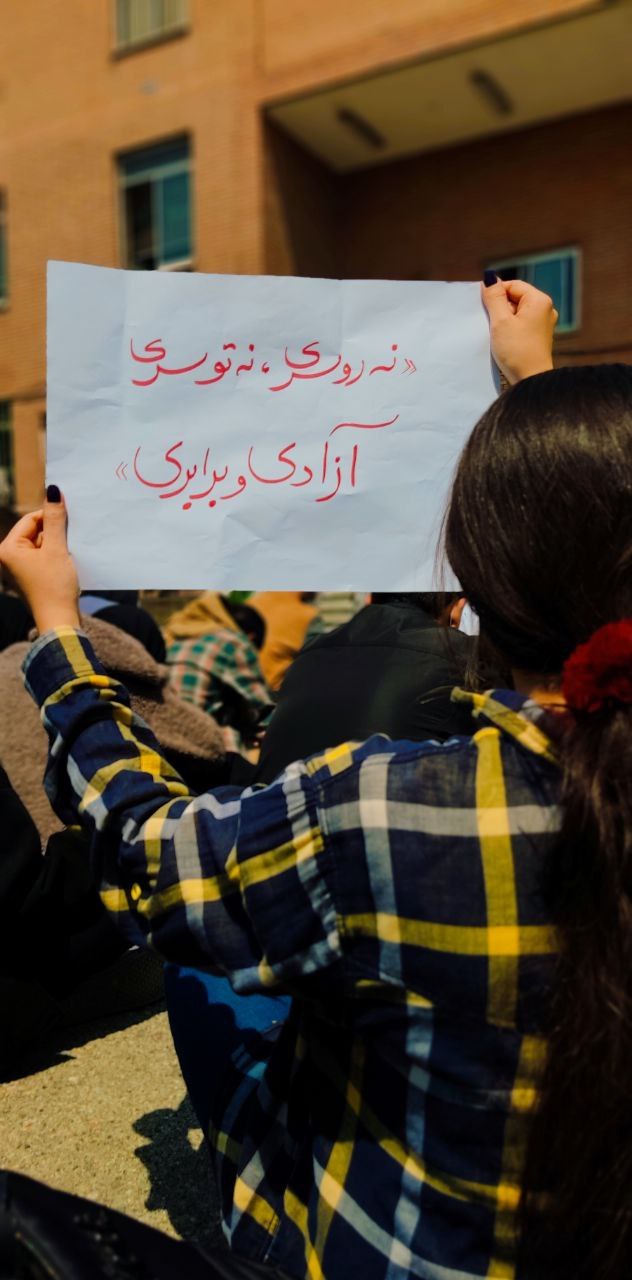
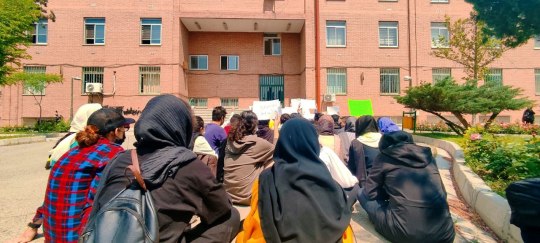
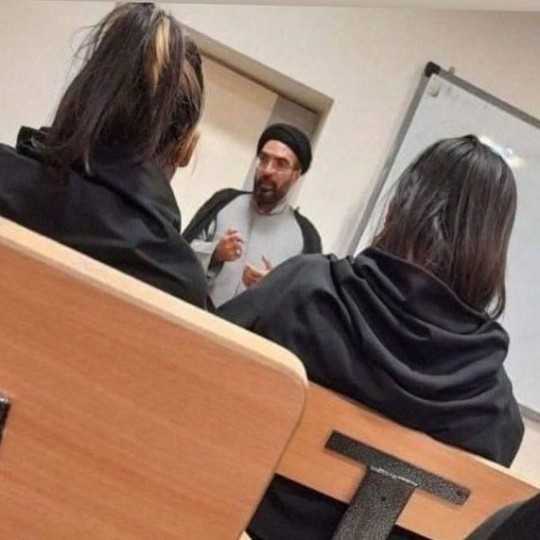

The regime's response to students taking off their hijabs is sending threatening messages to students' phones and increasing the security people. At the entrance of Universities, these security forces check people's clothes and if it's not proper they won't let you in. Some of the students wear the hijab at the entrance and take it off after they're in. They have warned our professors to not let non hijabi students sit in classes too.
One of my favorite trends in Iran now is when guys wear our hijab. These pictures are from universities. Guys wearing hijab make the security mad. This is a great act of solidarity with women against the obligatory hijab.


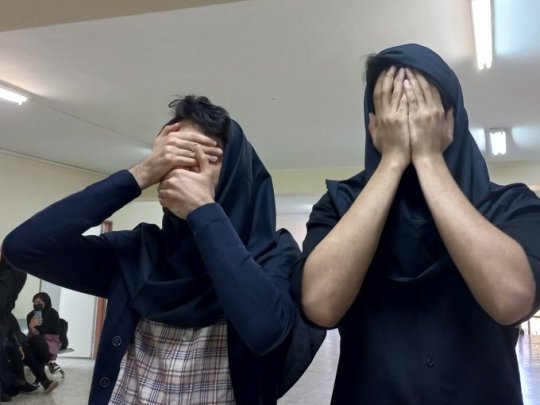
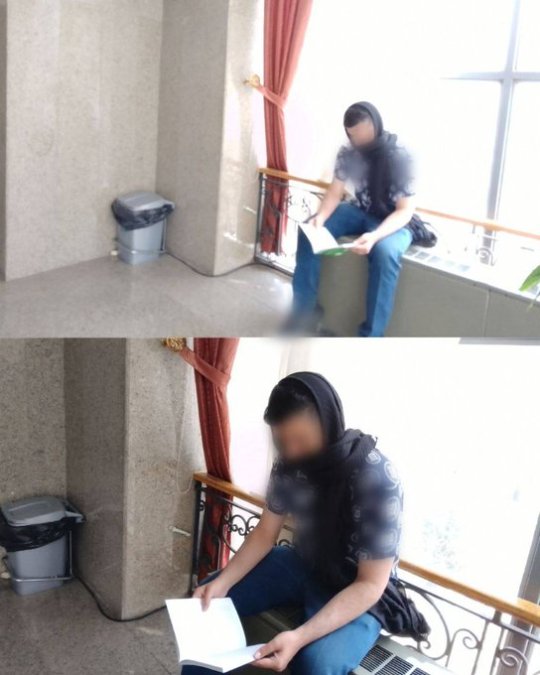
Some men have been doing either this or wearing shorts in public. The former is to ridicule the obligatory dress code and the latter is because wearing shorts in public is forbidden for guys too.
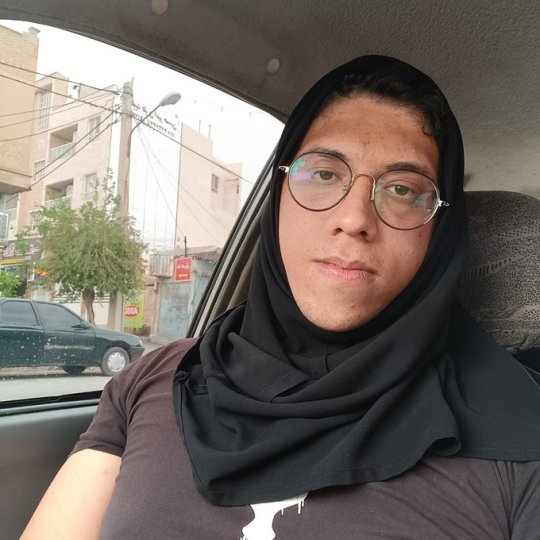
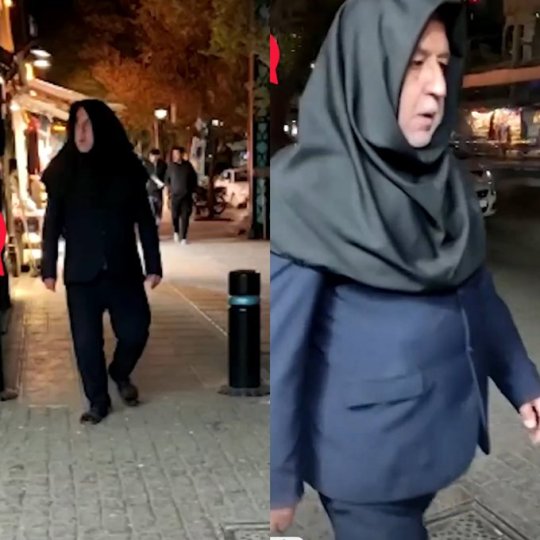
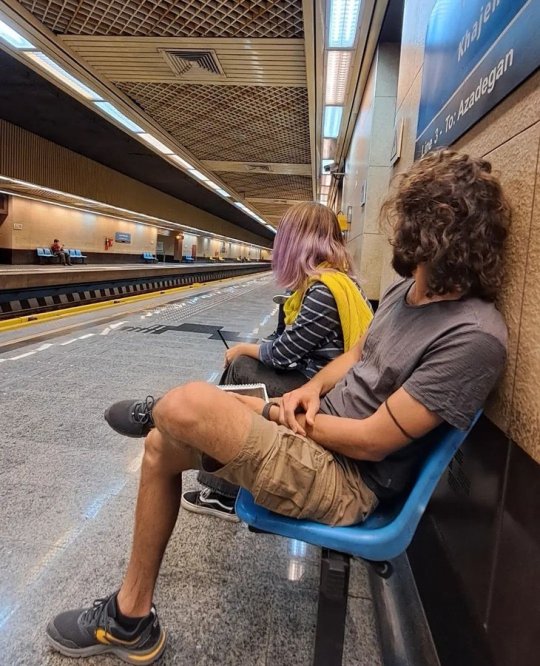
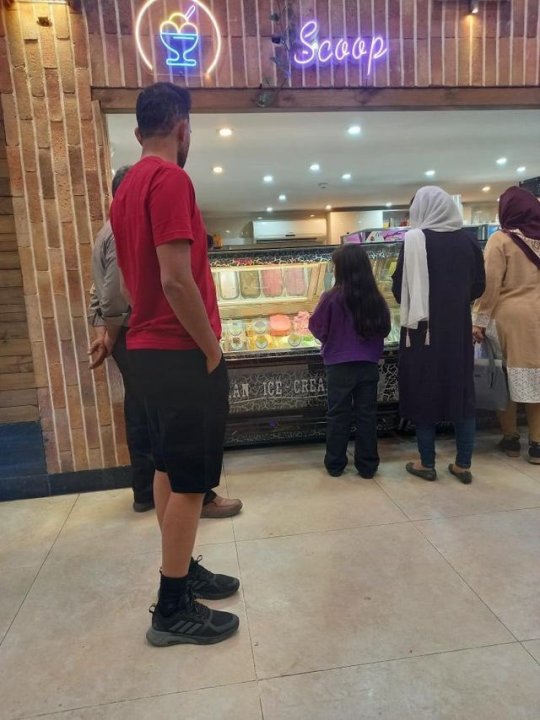
And women not wearing hijab in general. Though hijab is not our only issue, we want a whole new political system, one that is not theocratic or terroristic, hijab is something the regime won't back down from because it's one of their strongest oppressing tools. If they let us win the fight against obligatory hijab, I quote from a regime head, "people keep demanding more changes"!
So to put people against people to enforce the hijab law again, the regime has closed down many businesses (hotels, cafes, malls, bookstores, etc) for welcoming non hijabi female costumers. They have also warned taxi and bus drivers to not let non hijabi women in their vehicles.
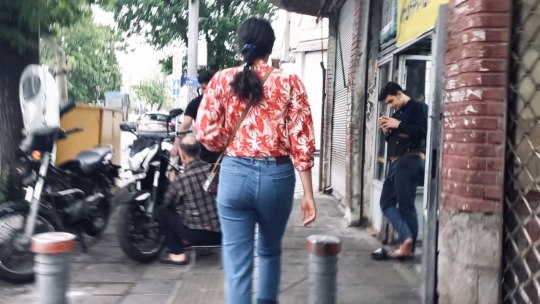
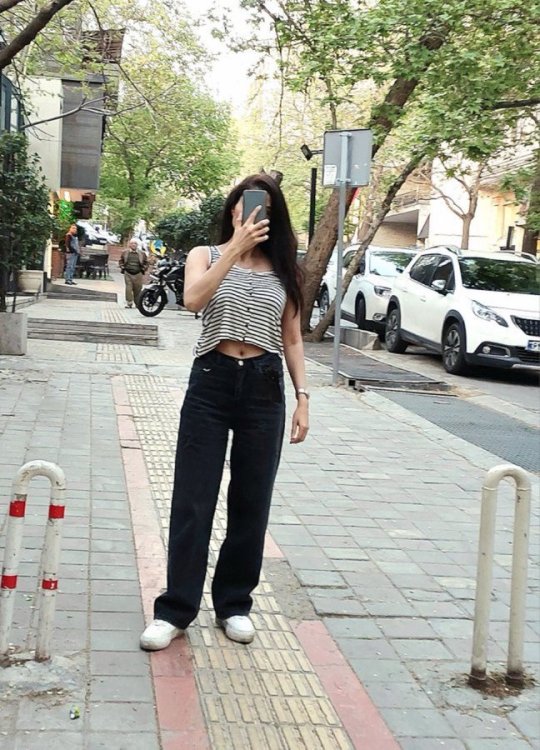
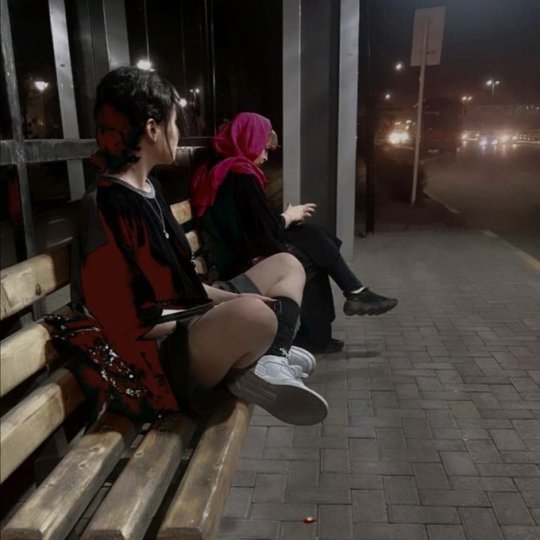
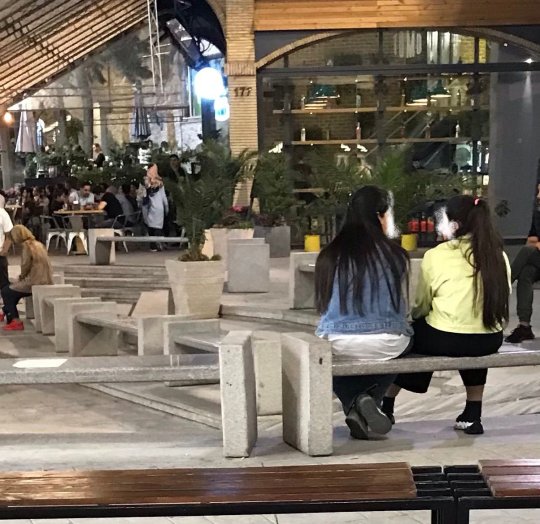
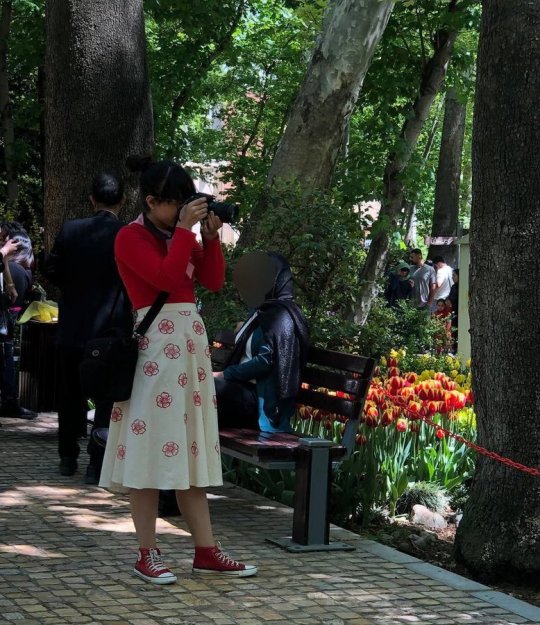
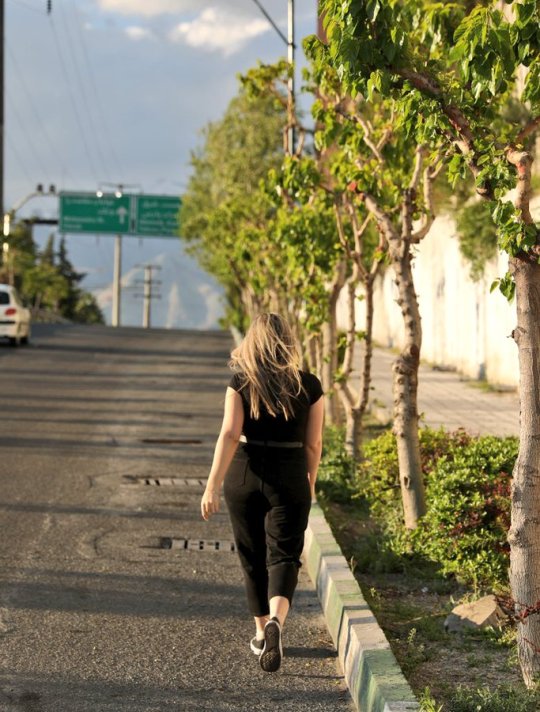



Although not everyone is disobeying the hijab law (some believe in hijab, some don't want to pay the price), the number of women who take the risk and don't wear hijab in Tehran and many other cities is high enough that you feel encouraged to keep doing it.
#iran#iran protests#iran revolution#mahsa amini#jina amini#jin jiyan azadi#women life freedom#politics#human rights#feminism#middle east#women revolution#obligatory hijab#university student#civil disobedience
2K notes
·
View notes
Text
Is the hijab a choice?
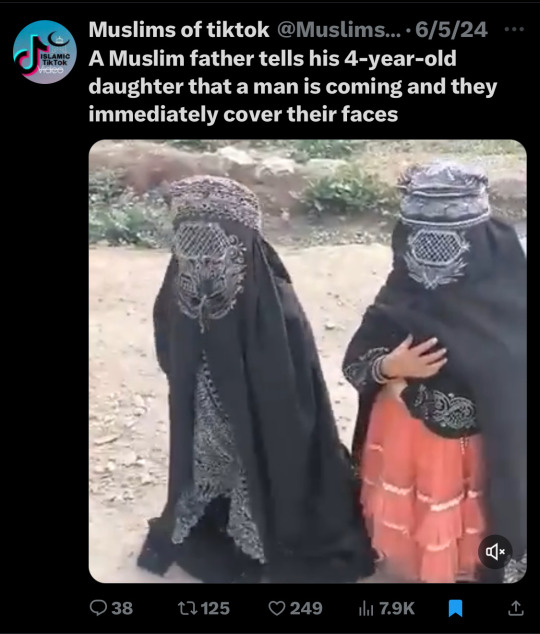
In the 4 madhabs, or schools of Islamic thought, there is often disagreements on Islamic rulings. There is no disagreements on the women’s awrah though.
The “awrah” is the shameful part of the body that must be hidden from public view. There is different rules for what can be shown to family members, non Muslim women, or strange men. The ruling for the public view of a woman’s body is that she must cover all except her face and hands.
To make matters worse, covering the awrah is Fardh. Fardh means compulsory. If you do not follow a compulsory command of Allah, and it is not forgiven before the day of judgment, you go to hell. Now whether or not you stay in hell forever there is disagreement on, but it begs the question:
Is hijab a choice? How can it be a choice when the threat of hell is looming over a girl, and conditioned into her for her entire life?
Muslimahs are coerced into wearing the hijab, and it is a clearly misogynistic and patriarchal expectation of women that must be abolished.
279 notes
·
View notes
Text
honestly i don’t mind ppl blaming religion, i just have a pet peeve for ppl treating islam as an outlier religion that is especially evil when all these religions place women as the “inferiors” who should not speak in certain settings and place men as their guardians. this absolutely is religious extremism & misogyny, and they definitely use religion (in this case, islam) to justify & validate their misogynistic ideals. that said, at the end of the day, religion is the means of enabling oppression not the source of the oppression. i don’t think men would cease to oppress women in this way if religion ceased to exist, bc the reason religion is the way it is is bc men have used it to validate their oppression of women.
#idk if that makes sense but yeah#obviously if my goal is to place islam as especially good i wouldn’t have posted this video#but like .. it’s not religion that’s not allowing women to speak regardless. that is men doing that#i think this ideal does come from hadith perhaps but it’s all based on interpreting the texts in whichever way that enables oppressing women#same way with hijab even tho there’s no text explicitly saying women should wear hijab in the quran#men found a way to misinterpret the text enough to justify forcing women to wear hijab#at the end of the day it’s men
256 notes
·
View notes
Text

THE SUDRA
The sudra is a traditional Jewish headdress with a history dating back thousands of years to the Biblical period and ancient Mesopotamia. It was worn like a turban or a headscarf and was of great spiritual importance at various points throughout history; for example, it’s mentioned directly in the Babylonian Talmud (written between the years 500-700). There are also some likely references to it in the Tanakh, such as in Exodus and the Book of Ruth.
CUSTOMS
Beyond spiritual significance, the Babylonian Talmud describes how it is customary to let another man hold one’s sudra as a gesture of trust during a monetary transaction.
In the Shulchan Aruch, there is an exemption for the sudra regarding the use of tzitzit. Even though the sudra is a four-cornered garment, tzitzit aren’t required.
Among Sepharadim, the sudra was worn over the shoulders like a scarf, while Ashkenazim wore it “coiled round the body like an Egyptian snake” or like the “kaftanis of the Tatars” when worn on the head. In fact, the sudra is likely the predecessor of the shtreimel (the fur hat worn by some Ashkenazi Jewish men), as Ashkenazi Jews in Europe eventually replaced the scarf with more weather-appropriate fur.
SUDRA IS OUTLAWED
With the expansion of the Arab and Islamic empires starting in 632 CE, Jews became “dhimmis,” relegated to second class citizenship and a whole host of prohibitions. Among those prohibitions was the use of the sudra. For example, in Yemen in 1667, the Jewish sudra was banned, likely to humiliate the Jewish community by forcing them to place regular clothes on their heads. The Jewish community bribed some government officials to reverse the decision. Ultimately a deal was struck where Jews were permitted to wear the sudra so long as it was made of bad quality cloth.
As the Arab keffiyeh became associated with Arab Muslims of high status, Arab rulers once again instituted prohibitions on the Jewish sudra because it was too similar to the keffiyeh.
DECLINE AMONG ASHKENAZIM
Jews in Europe still used the traditional sudra well into the 16th century, some 1500 years after their exile from Judea (Israel-Palestine today). In the Shulchan Aruch, Rabbi Moses Isserles specifically mentioned the significance of the sudra among Ashkenazim.
In the Middle Ages, the use of turbans such as sudras were outlawed in Europe, resulting in the gradual decline of the sudra among Ashkenazi Jewry. Eventually the sudra evolved into other forms of “legal” and weather-appropriate dress, such as the shtreimel, as discussed previously.
DECOLONIZATION OR APPROPRIATION?
Among other things decolonization is the process of removing the layers of oppressive foreign imperial and colonial influence imposed upon one’s culture. As discussed, Jews have worn the sudra since ancient times, dating back thousands of years. The garment came into disuse due to the oppressive laws of powerful empires, both in Southwest Asia/North Africa and among Jews in Europe. Reclaiming the sudra, which also happens to be of great spiritual significance, is an act of decolonization.
The keffiyeh, which uses a similar pattern, became a symbol of Palestinian nationalism and resistance in the 1930s (after longtime use among Palestinian farmers and others in Arab nations). Kurds, Persians, Yazidis, and other Indigenous Southwest Asian groups also traditionally use keffiyehs. In fact, the keffiyeh and the sudra likely have the same origin; that said, the sudra predates the keffiyeh by hundreds of years.
The Jewish reclamation of the sudra should not be weaponized to harm Palestinians. That said, claiming that Jews are “appropriating” keffiyehs while using the sudra is absurd, seeing as the sudra not only came before the keffiyeh, but is also a garment of spiritual significance for Jews that was still used relatively recently in the scope of Jewish history. Ultimately, we have to remember that Jews and Palestinians are historic, cultural, and ethnic cousins, and, as such, some parts of our cultures will overlap.
#jumblr#jewblr#jewish tumblr#judaism#jewish#jewish history#funkowrites#antisemitism#rootsmetals#stop antisemitism
183 notes
·
View notes